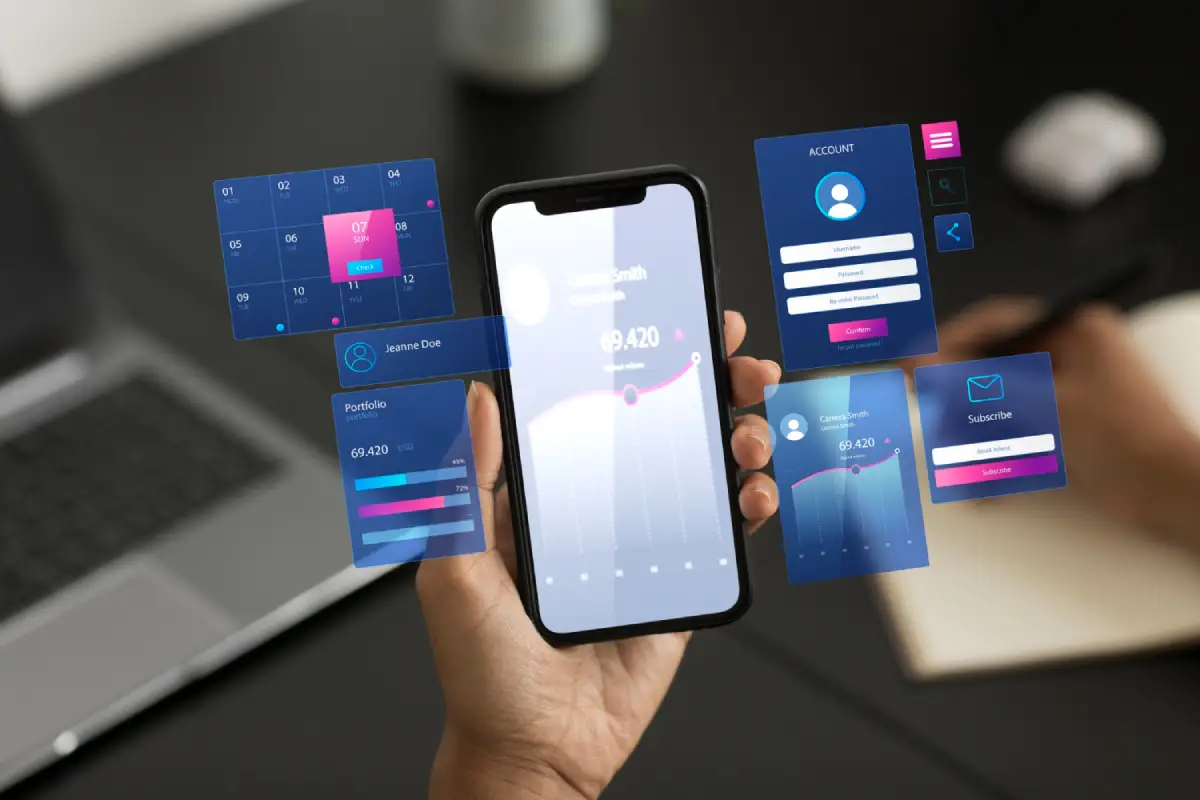Integrated Business Applications in Dynamic Business Environment and User Experience
The successful integration of applications has become essential in today’s dynamic business environment. The importance of integrated business apps has increased as companies aim for more agility and efficiency. The user experience (UX) of these applications is one of the key elements influencing their success. We examine the significance of user experience in integrated business apps in this in-depth blog post, as well as how it affects output, worker happiness, and overall company success.
Integrated business applications enhance department collaboration and streamline operations by integrating multiple resources and tools into a unified environment. Such applications comprise enterprise resource planning, ERP systems, customer relationship management (CRM) software, and other customized programs designed to meet certain business requirements.
User experience includes all of the interactions that users have with integrated apps, not just the interface design. A satisfying user experience guarantees that staff members can operate the system with ease, complete jobs quickly, and benefit from the integrated features. On the other hand, an unsatisfactory user experience can cause irritation, lower productivity, and reluctance to the usage of integrated technologies.
Key Elements of a Positive User Experience
For an experience to be positive, an intuitive user interface is essential. Applications that are integrated ought to have a unified look and feel, facilitating users’ comprehension and smooth transition between various sections. Logically arranged menus, workflows, and icons will help novice users acclimatize more quickly. User experience includes interoperability and accessibility across several devices. Whether accessed from a PC, tablet, or smartphone, responsive integrated applications guarantee a constant user experience. For a system to support a wide range of user preferences, it must be compatible with different operating systems and browsers.
The foundation of integrated business software is an efficient workflow. The system should enable seamless transitions between various modules and allow users to complete activities with the fewest clicks possible. Repetitive process automation increases user productivity and lowers error risk. Enabling consumers to customize their workspace enhances the user experience. People may personalize the integrated application to fit their unique responsibilities and preferences thanks to customizable dashboards, reports, and settings, which encourage a sense of control and ownership. Applications that are integrated ought to encourage users to collaborate in real-time. The application’s communication tools, collaborative editing capabilities, and shared documents improve teamwork and communication by dismantling departmental silos.
Good user experiences require readily available support channels and extensive training materials. Sufficient tutorials, assistance materials, and onboarding procedures enable users to fully utilize linked applications. Increased productivity in integrated business applications is closely correlated with a well-designed user experience. Workers can complete jobs quickly, obtain pertinent information quickly, and work along with coworkers without difficulty. Enhanced productivity through streamlined processes frees up staff members to concentrate on high-value tasks that advance organizational goals.
Additionally, a good user experience reduces the learning curve that comes with new updates or applications, guaranteeing a quicker acceptance rate among staff members. People are more inclined to adopt technology when they perceive the integrated tools as user-friendly and advantageous for their everyday jobs, which can result in increased productivity levels within the company.
Employee Satisfaction and Engagement:
User experience significantly influences employee satisfaction and engagement levels. Employees who find integrated applications intuitive and user-friendly are more likely to feel empowered in their roles. The satisfaction derived from using efficient tools positively impacts morale and job satisfaction.Additionally, a positive user experience contributes to a sense of engagement with the organization’s technological ecosystem. Employees become more willing to explore additional features and functionalities, contributing to ongoing innovation and improvement. This engagement fosters a positive work culture where employees feel supported by the tools at their disposal, leading to increased loyalty and retention.
The impact of user experience in integrated business applications extends beyond individual productivity and employee satisfaction; it directly contributes to overall business success.When users can access relevant information effortlessly and navigate through integrated data, decision-making processes become more informed and efficient. Integrated applications provide a holistic view of business operations, enabling leaders to make strategic decisions based on real-time insights.For businesses with customer-facing integrated applications, a positive user experience translates to improved interactions with clients. Sales and customer service teams can access comprehensive customer profiles, historical data, and communication records, fostering stronger and more personalized relationships.
In an ever-evolving corporate environment, the ability to adapt to change is crucial. Transitions between new modules, organizational changes, and software updates are made easier by integrated apps that provide positive user experiences. This adaptability ensures that the business will always be quick to react to market developments and responsive. By creating efficient workflows and reducing training durations, organizations can save money. Satisfied users are less likely to make mistakes, require significant support services less frequently, and make the most of integrated products, all of which have a positive financial impact on the business.
Challenges and Considerations:
Businesses may face challenges in putting the user experience first in integrated business systems, but there are numerous benefits. Several apps may be challenging to integrate, especially if you’re using outdated software or providers’ apps. A faultless user experience can only be guaranteed by meticulous planning and coordination, which also helps to tackle integration problems. Security has to come first in integrated systems since they need data sharing between multiple modules. To ensure that data protection regulations are followed and sensitive information is protected, organizations need to implement robust security measures.
Even with intuitive design, proper training is essential for users to maximize the benefits of integrated applications fully. Organizations should invest in comprehensive training programs to familiarize users with the functionalities and features of the integrated system.User experience is an evolving aspect of integrated applications. Regular assessments, user feedback, and updates are necessary to address evolving user needs and technological advancements. Organizations should prioritize a culture of continuous improvement to stay ahead of user expectations.
Best Practices for Optimizing User Experience in Integrated Business Applications:
To maximize the positive impact of user experience in integrated business applications, organizations can follow many of the best practices. Regularly gather feedback from users to understand their experiences and identify areas for improvement. This feedback loop is instrumental in refining the user interface, addressing pain points, and aligning the application with user expectations.
Place users at the center of the design process. Engage UX designers to create interfaces that prioritize user needs, simplify workflows, and enhance overall usability. Iterative design processes, such as prototyping and usability testing, can help refine the user interface.Invest in comprehensive training programs to onboard new users and ensure ongoing skill development. Training should not only focus on basic functionalities but also highlight advanced features that can contribute to enhanced productivity.
Promote cooperation amongst end users, UX designers, and IT teams. Using a collaborative approach guarantees that integrated application design and deployment meet technical and user-centric criteria. Collaboration across functional boundaries aids in bridging the gap between user expectations and technical viability. Strong security measures should be incorporated into integrated application design and deployment. To protect sensitive company data, encryption, access limits, and frequent security audits are necessary. A secure system builds user trust while safeguarding the company.
User Analytics & Scalability:
To learn more about user behavior and interactions with integrated applications, take advantage of user analytics technologies. By examining user data, one can find trends in usage, determine what features are most popular, and discover areas that might use improvement. Informed by statistics, decisions are made about upcoming updates and improvements.
Take into account an integrated application’s scalability to meet the organization’s changing needs. The connected ecosystem should grow with the business to accommodate more users and provide new features without sacrificing user experience or performance. Acknowledge that consumers may utilize a variety of routes to access integrated applications. Make sure that the user experience is the same across various platforms and devices. Providing multichannel help improves accessibility and takes into account the preferences of different users.
Set up key performance indicators (KPIs) in line with goals that are focused on the user. Metrics like job completion times, user satisfaction ratings, and error rates offer important information on how well-integrated apps work from the standpoint of the user experience. Stay up to date with industry developments and technology breakthroughs that could affect user experience. New technologies that can improve user interactions in integrated business apps include augmented reality and artificial intelligence.
Conclusion
User experience is a strategic requirement in the world of integrated business systems, not just a design philosophy. Employee engagement, productivity, and happiness are all boosted by a pleasant user experience, which eventually benefits the company as a whole. Businesses need to understand the mutually beneficial relationship between technology and user experience as they work through the challenges of integrating multiple apps. Through the adoption of optimal methodologies, resolution of obstacles, and cultivation of a user-focused perspective, enterprises can develop integrated business applications that not only optimize processes but also enable users to prosper in a networked digital environment.
The journey towards optimal user experience in integrated business applications is an ongoing pursuit—one that requires continuous refinement, adaptability, and a commitment to placing users at the forefront of technological innovation. As organizations embrace this holistic approach, they position themselves not only for improved operational efficiency but also for sustained success in an ever-evolving business landscape.
Frequently Asked Questions:
In the context of integrated business applications, what does user experience (UX) mean?
In Integrated Business Applications, User Experience (UX) describes how end users feel about the software’s overall usefulness and satisfaction. It includes the application’s efficiency, design, and accessibility in delivering a smooth and pleasurable user experience while dealing with its many integrated functions.
In Integrated Business Applications, why is User Experience significant?
Since it has a direct impact on output, effectiveness, and user happiness, an excellent user experience is essential for integrated business applications. The adoption of integrated features is increased by well-designed and user-friendly interfaces, which improves productivity and overall business efficiency.
What role does the design play in enhancing User Experience for Integrated Business Applications?
Design is fundamental in creating an intuitive and visually appealing interface. It involves organizing information, streamlining workflows, and ensuring that users can easily navigate through the integrated features. A well-thought-out design contributes significantly to a positive User Experience.
How can accessibility be ensured in Integrated Business Applications to cater to a diverse user base?
Accessibility is vital for inclusivity. Integrated Business Applications should adhere to accessibility standards, providing features such as screen reader compatibility, keyboard navigation, and adjustable font sizes. This ensures that users with diverse abilities can effectively utilize the application.
What measures can be taken to optimize performance and speed in Integrated Business Applications?
To optimize performance, developers should focus on efficient coding practices, minimize unnecessary data requests, and employ caching mechanisms. Regular performance testing and monitoring are essential to identify and address any bottlenecks, ensuring a smooth user experience.
How can user feedback be integrated into the improvement process of Integrated Business Applications?
Establishing feedback loops through surveys, user testing, and monitoring user behavior is crucial. Analyzing feedback allows developers to identify pain points, address usability issues, and continuously enhance the application to meet user needs and expectations.
What security considerations should be taken into account when designing User Experience for Integrated Business Applications?
Security is paramount. User Experience design should include measures to protect sensitive data, ensure secure authentication, and prevent unauthorized access. It is essential to stay updated on security best practices and incorporate them into the application’s design and functionality.
How can training and onboarding processes be designed to ensure a smooth transition for users in adopting Integrated Business Applications?
Providing comprehensive training materials, tutorials, and onboarding processes is essential. User-friendly documentation, interactive training modules, and responsive support channels can assist users in becoming proficient with the integrated features, reducing resistance to change.
In the context of integrated business applications, does user experience have an impact on overall business ROI?
Increased user adoption, productivity, and satisfaction are indeed directly correlated with a positive user experience. These elements support the success of Integrated Business Applications as a whole and increase the business’s return on investment (ROI).
How often should user experience be reviewed and enhanced in integrated business applications?
The user experience ought to be a continuous effort. Integrated business apps are kept user-centric and in line with changing business requirements through routine evaluations, analysis of user feedback, and adaptation to new technologies. Maintaining success over time requires constant improvement.
Need support? You are our priority, We’ve got you covered.
Rapid response time to service requests, responding to all customer feedback to get in touch.
Our goal is to supply you with the best possible customer service across all our products and solutions. We look forward to helping you make the most of your AlxTel platform.












